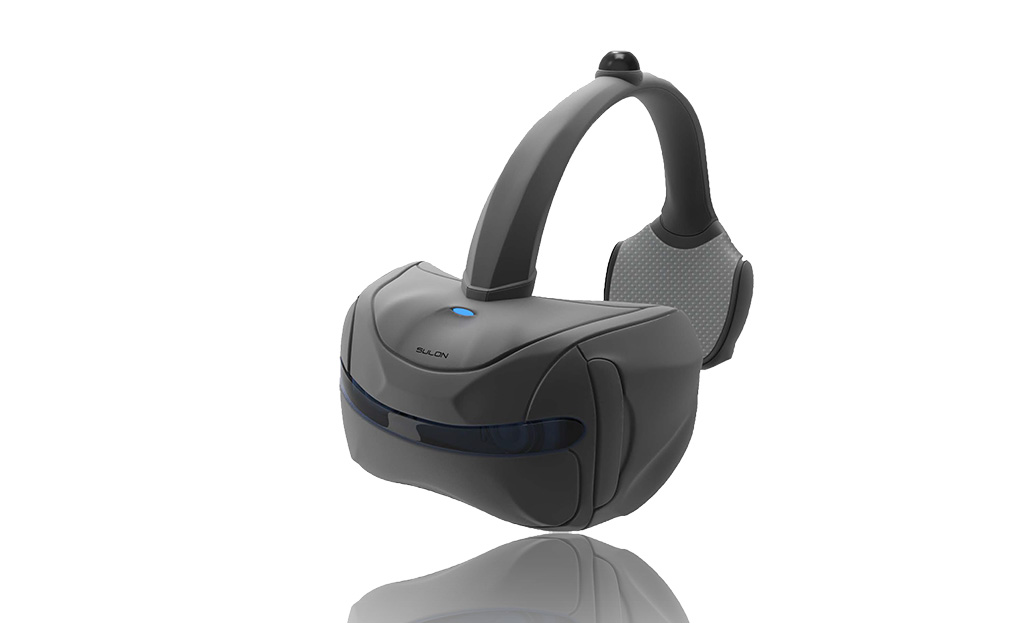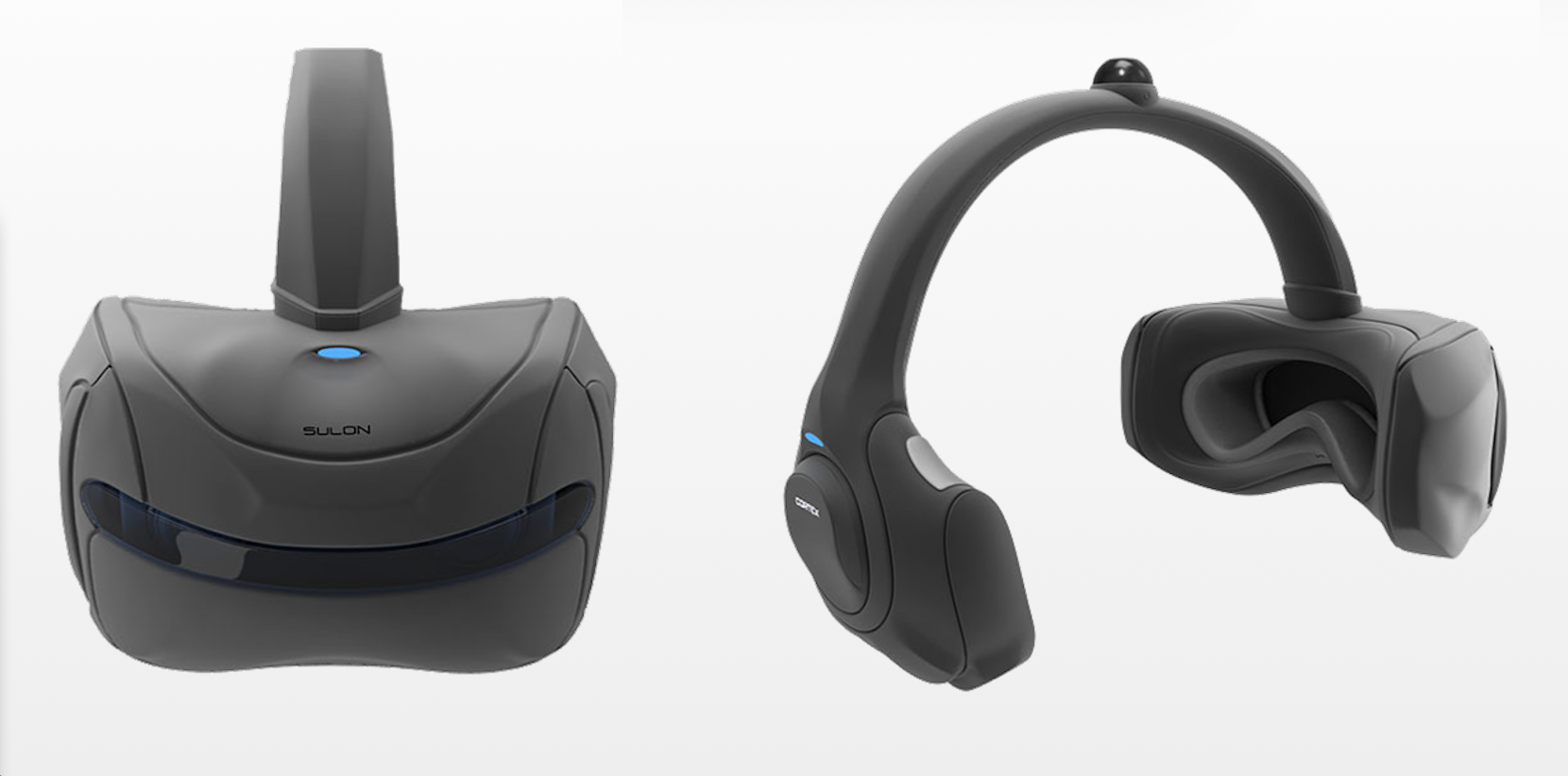The Past, Present, And Future Of VR And AR: The Pioneers Speak
Sulon Cortex
Sulon Technologies made its big debut at GDC 2014. While the industry was abuzz about VR on a big console platform, this Canadian start-up quietly wowed everyone who tried its demo in San Francisco. Rather than pigeonhole itself as VR or AR, the Sulon Cortex uses a combination of both technologies. Rather than integrate a screen into the hardware, the Cortex leverages the display from an Android phone. What sets the Cortex apart, though, are spatial cameras that translate your real world environment into a virtual one. If you can imagine your living room being transformed into a space station overrun by zombies, then you have a pretty good idea of what Sulon is aiming to achieve.
The answers to our questions were a Sulon Technologies team effort.
| Spatial Scanner | |
|---|---|
| Type | 3D Mapping |
| Angular Range | 360º |
| Speed | 20 ms per scan (expected) |
| Distance | Up to 132 feet scanning radius |
| Accuracy | +/- 10 mm |
| Spatial Processing Unit | |
| Processor | 1.5 GHz Dual-core ARM-based processor running Linux OS |
| Memory | 1 GB |
| Connectivity | 802.11b/g/n/ac, Bluetooth 4.0, USB 2.0 |
| Sensors | 3-axis Gyroscope, 3-axis Accelerometer, 3-axis Magnetometer |
| Degrees of Freedom | 9 DoF |
| Battery Life | 4 hours |
| Cortex Visor | |
| Optics | 140º Field of View (FOV) |
| Compatible Devices | Fits most Android mobile devices from 5.5” to 7.0” (list coming soon) |
| Cortex Controllers | |
| Tracking Technology | 3D spatial magnetic positioning |
| Accuracy | 1 mm (positional), 1º (angular) |
| Input | Joystick, D-pad, 4 buttons, 2 triggers, start button |
Tom's Hardware: Is your technology based on AR or VR, and why?
Sulon: The Sulon Cortex is a spatial entertainment platform that transforms any physical environment into a holodeck-like experience. The technology behind the platform utilizes a unique hybrid of AR and VR technologies. Video gaming entertainment has traditionally been a stationary affair, where the user is sitting in front of a TV or monitor and bound to that area. We have taken that immersion one step further by granting users the ability to freely move (untethered) in their desired game area, whether that is their bedroom, their entire home or even outdoors. The AR aspect of the technology allows the user’s surroundings to be integrated into the game and for the Cortex to be spatially and contextually aware. Combining AR and VR, the Cortex creates a fully immersive and dynamic gaming experience from your own living space.
Tom's Hardware: When will we see mass adoption of VR and AR technology (defined as more than one million customers)?
Sulon: We believe that the mass adoption of AR and VR is just around the corner and that we’ll definitely be seeing more of these technologies in our daily lives in the next couple of years. From a market perspective we see many small and large companies alike investing in the development of consumer friendly AR and VR products. There has been a surge in the past two years or so in the number of AR/VR projects making appearances and being successfully funded on crowdfunding platforms like Kickstarter. More established companies have also been pushing forward such as Google with the Google Glass and Qualcomm with their Vuforia platform. Facebook’s recent acquisition of OculusVR is another indicator of the direction the market is moving in and how quickly these AR/VR technologies are coming out of R&D and into the hands of the consumer.
Tom's Hardware: What are the technical hurdles still standing in the way?
Get Tom's Hardware's best news and in-depth reviews, straight to your inbox.
Sulon: The Cortex is a wireless, plug-and-play system powered by a user’s mobile device. We are strong advocates that the next generation of interactive entertainment should be wireless and portable. Our goal is to bring the most immersive and realistic gaming experience to consumers on a mobile platform. To achieve this immersion, the technical hurdles that we need to overcome are related to reducing latency and developing the tools necessary to create spatial games and content.
Tom's Hardware: What are the non-technical hurdles standing in the way?
Sulon: Product adoption and price are two major non-technical hurdles that stand in the way of mass adoption, and they often come hand-in-hand. For mass adoption of new and disruptive products to occur, consumers must be aware that the products and technology exist, understand the value it adds to their lives, be able to visualize themselves using it and know where it is available for purchase. AR/VR products also need to be priced competitively and at ranges that consumers feel are reflective of their value.
Software content is another hurdle that new gaming platforms face, which also ties back into adoption. All too often we’ve seen new and game-changing systems launch, but fail because they did not have enough software supporting it.
Tom's Hardware: What steps are needed to remove those hurdles?
Sulon: Strategic partnerships and out-of-the-box thinking are required to successfully remove these hurdles. Identifying, approaching and maintaining the right strategic alliances with leading global organizations and individuals will eliminate many of the hurdles associated with launching new technologies. These alliances bring together the knowledge, experience and connections required to ensure success via the development of cutting edge designs, concepts and technologies. Out-of-the-box thinking is required on all levels to create innovative solutions and strategies to overcome commercialization challenges.
Tom's Hardware: What is your company doing specifically and technically to remove those hurdles?
Sulon: Sulon is fully aware of what the challenges are and we are actively working towards overcoming them. The Cortex is designed and developed with these challenges in mind. For example, by leveraging existing mobile devices we are able to lower the price and increase adoption through familiarity. Because the Cortex utilizes smartphones, the learning curve associated with adopting a new product and technology are substantially lower. The system is also compatible with existing Android-based and PC games thus relieving some of the immediate need for spatial gaming content.
To complement the Sulon design and development team, we have tapped into some of the brightest minds in the industry through research and development collaborations with leading universities and colleges across North America to tackle the issue of latency and content creation. We also have several partnerships with well-known companies throughout the globe who are just as passionate as we are about changing the way interactive entertainment is consumed today.
Internally we have developed a marketing strategy that involves multiple activities and events that build awareness of the Cortex through opportunities to see, feel and try the system. We are also taking an aggressive approach for the consumer launch of the Cortex. Consumers can expect to see a multitude of unique features and functionality designed to be seamlessly integrated into their lives at a price point that is competitive and affordable.
Tom's Hardware: How will VR and AR change the gaming ecosystems in the future (PCs and components, consoles, controllers, and the games themselves)?
Sulon: We believe the AR/VR technologies will have a substantial impact on gaming ecosystems in the future. It is undeniable that there will always be a market for gaming in the platforms of PC, console, handheld and mobile. AR/VR technologies are not designed to replace these forms of gaming but rather to complement and add another dimension of game play to the equation. The Cortex for example, is compatible with existing Android-based mobile games and able to stream high quality PC/console quality games in addition to its AR and VR spatial games. The Cortex and other disruptive technologies will change the entire gaming industry through the seamless integration of various gaming platforms.
Tom's Hardware: How will VR and AR change the world outside of gaming? Give us the most remarkable, life-changing examples you expect to happen.
Sulon: Outside of gaming, the most remarkable and life-changing examples of AR and VR technologies can be a simple integration into our everyday lives such as visualizing and interacting with a prospective property without leaving your room or virtually traveling the world in your own home or even living a scene from your favorite movie. It could be as complex as specialized usages to save lives through training and simulation applications. More realistic and true-to-reality training exercises will better equip personnel with the knowledge, teamwork and experience to succeed through improved mental stability, in-field procedures and response time.
A great example of how AR technology can be used on the field is a fire fighter who must rescue someone trapped in a burning building. Utilizing Sulon’s spatial technology, they would be able to map the floor plan of the building in real-time despite low visibility (due to smoke). Sensors would be able to recognize and pick up specific sounds and locate where they are coming from. The system then processes this data, and augments arrows to direct the firefighter to the source of the sound. The Cortex can be used to recreate dangerous and life-threatening environments such as hostile situations and medical disaster relief efforts to maximize success and minimize human loss while on the field.
Read more: Sulon Cortex Blends Virtual Reality with Augmented Reality
-
icepick314 would Virtual Boy from Nintendo count as VR tech?Reply
it's missing in the article's timeline...
also an arcade game Time Traveler that had "holographic" screen... -
Cazalan I think they're wasting too much time on the motion capturing aspect. Just give me a headset that looks better than a 30" monitor and I'm sold.Reply -
Vlad Rose With the Virtual Boy, I would call it VR tech as it uses similar technology that used in the VR gear that is coming out. With Time Traveler and Holosseum, I would say no. What they used was a single 2D screen that was projected to a curved mirror to create a false reality of the image 'sticking out'. It is more comparable to 3D movies than Virtual Reality.Reply -
clonazepam The Vuzix seems pretty cool. We've already accepted bluetooth headsets and its a very similar look. I hope they all account for the fact that some people are right-handed and left-eye dominant or other way around, as well as color blind or red / green deficient.Reply
I think the Vuxio would be the most useful in everyday life, while obviously Oculus or Morpheus being the most fun. -
Shankovich Morpheus looks cool but it just can't compete with the rift when hooked up to the PS4; it just doesn't have the graphical power to run above 1080P games with acceptable level of detail, effects, etc. especially when the frame rate will need to be at 60fps or more to reduce nauseating effects. On PC, the rift has better sensors (geomagnetic) and is better able to take care of movement lag.Reply -
CaedenV @CazalanReply
Agreed. I am all for VR to hit when it is really ready, but until then I would be extremely happy with a high resolution headset to use as an immersive display. I don't want to have to crane my neck and change my body's orientation when gaming. I still want a keyboard/mouse or controller as input and be able to sit back on the couch and just play a game. I have a nice big yard to work on if I want something active to do... when I am gaming I want to get into it, but with the least amount of physical effort possible. -
Henderburn The VR timeline should include the release of "Snow Crash," the novel that inspired John Carmack and Michael Abrash to make Quake and build the foundations for VRReply -
WyomingKnott I'm still waiting for a decent eyeglass-size display so I can read a book while the dentist pokes at my teeth. Seriously, we don't have even the basic display element available commercially?Reply -
Cybolic Vuzix examples are probably the worst I've ever heard: "having a sales associate be able to answer your questions" and "see exactly where your veins are so they only stick you once with the needle to get the blood", yeah, they are supposed to already be able to do that without wearing special glasses; it's literally what they're being paid for.Reply


